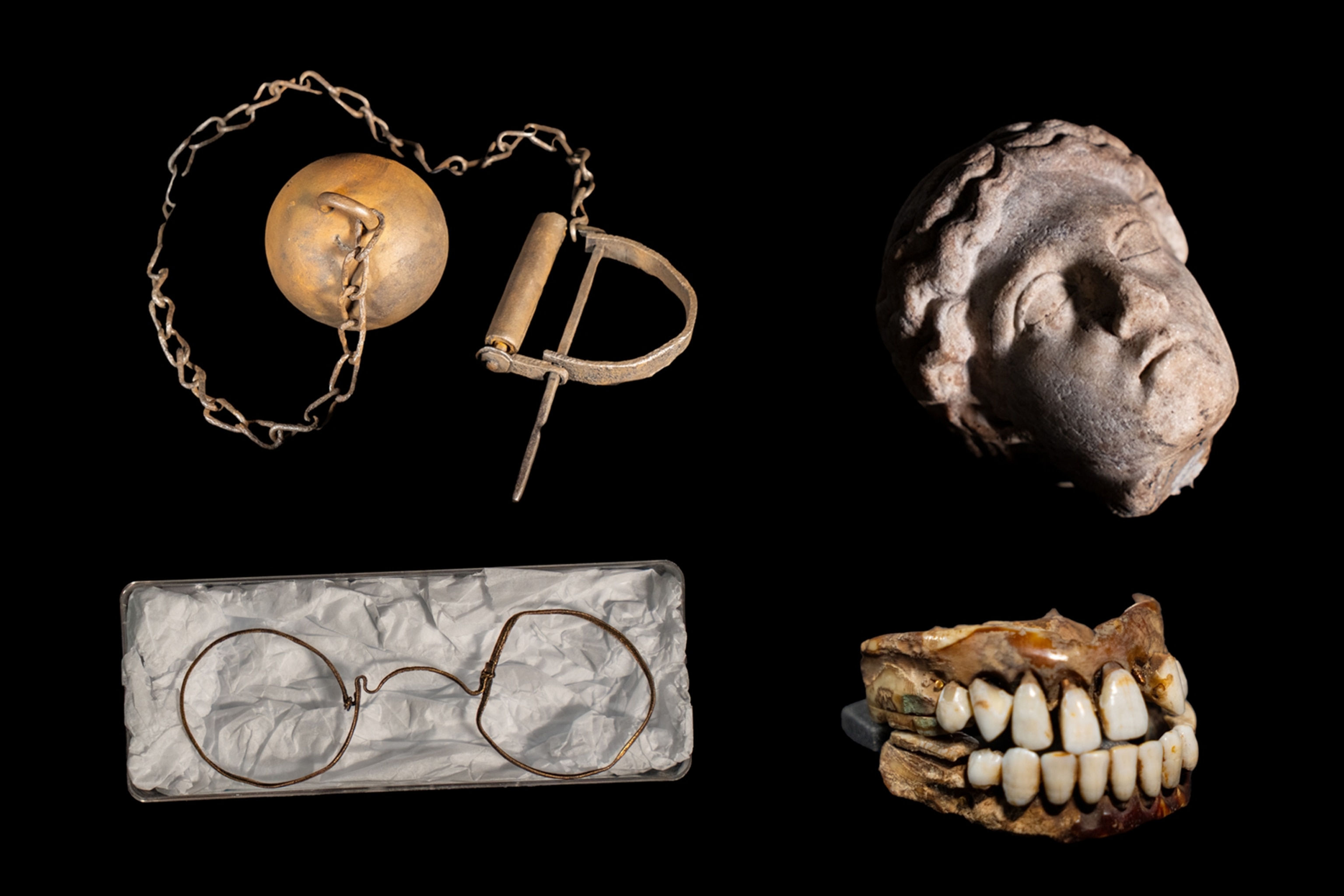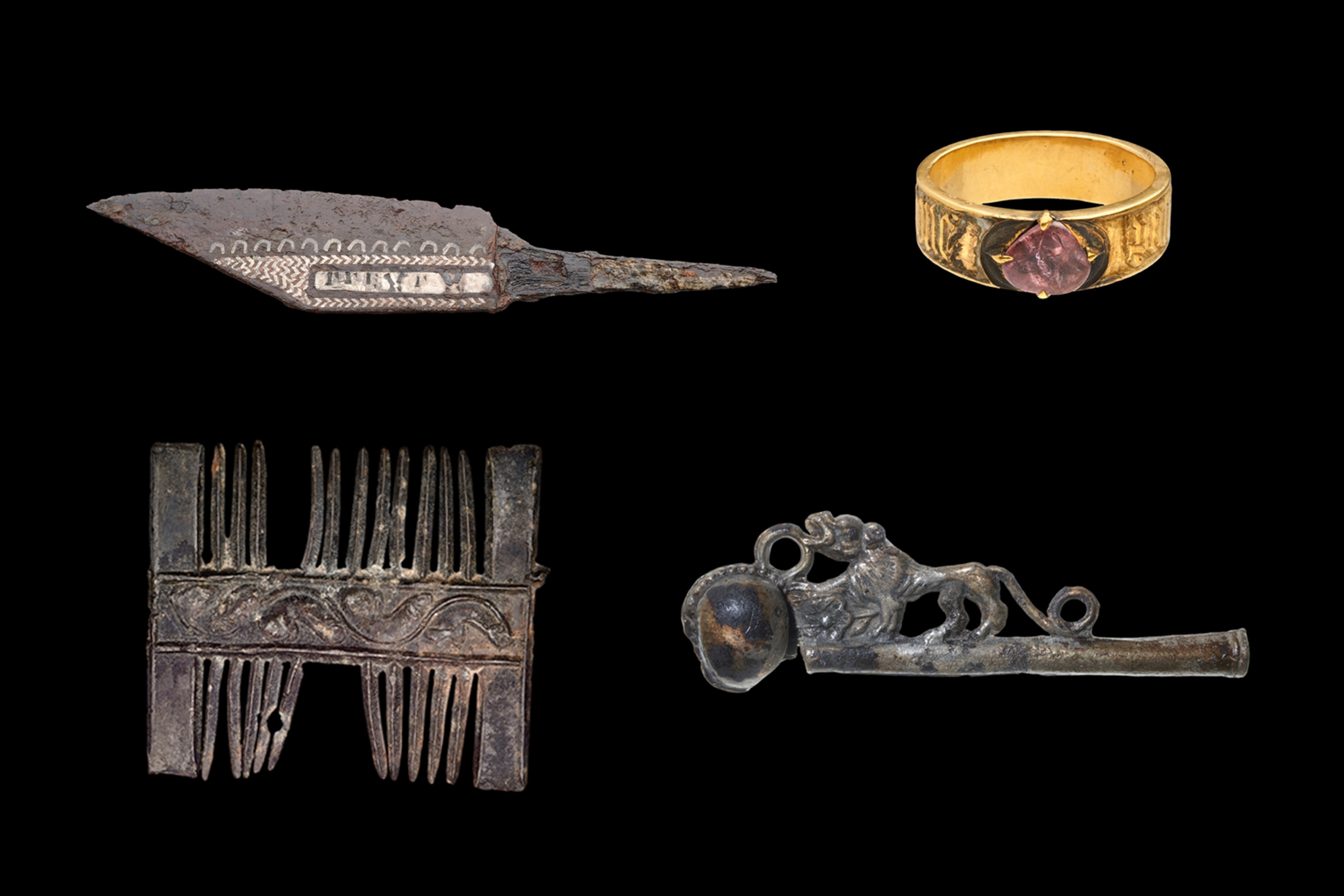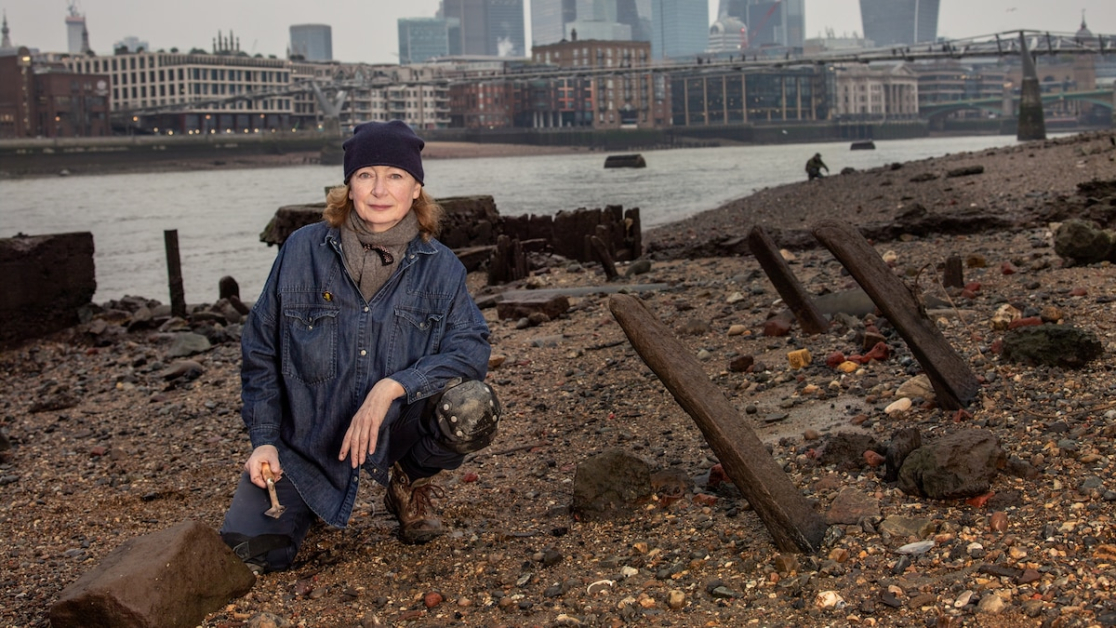ON A SUMMER DAY in central London, a 44-year-old woman named Lucy Peel descended a slippery stairway on the bank of the River Thames to crouch on her hands and knees over a particularly intriguing pile of mud. It was low tide, and the waters of the river had receded substantially. Ignoring the obvious tangles of trash—plastic bags, vape pens, broken glass—Peel painstakingly scanned the exposed riverbed until she spotted something nestled in the sand that could easily be mistaken for a leaf. After carefully prying it loose, she held up a wafer-thin ceramic shard and had a familiar feeling that she was holding a piece of ancient history.
Later, an archaeologist would confirm her suspicion: It was a fragment of Roman pottery. “Even though it’s so fine, somehow it’s still survived 2,000 years of being in the Thames,” Peel marveled.
But the competition to find such relics has rapidly increased. Peel is a particular kind of amateur treasure hunter known as a mudlark. The term, originally used to describe poor Londoners who searched the river for scraps to sell in the 18th and 19th centuries, has found new meaning today among a growing number of hobbyists who hunt for artifacts along riverbanks around the world. One of the most iconic spots remains the Thames, which has seen thousands of years of habitation along its waterfront. With some 95 miles of riverbank subject to tides, its foreshore is the longest archaeological site in London.
Not only do centuries-old objects survive, but they sometimes emerge looking just like they did when they went into the mud. The river’s silt blocks out oxygen, meaning metals don’t rust and bacteria can’t decompose organic material. Twice a day, tidal shifts expose new trash and potential treasure from throughout the ages.
For decades mudlarks have been granted permission to hunt along the Thames by the Port of London Authority (PLA), which issued permits for up to three years at a time to a small community of hobbyists. But during the pandemic that community grew dramatically, causing the PLA to upend their application process. They recently announced they are capping the total number of permits, each only valid for one year. To accommodate the surge in interest, the agency created a waiting list, which quickly increased to more than 10,000 people and was closed. Active permit holders could not join the list until their current permit was close to expiring, and many veteran mudlarks missed the window. They fear it might take years to get another permit.

These remarkable finds are featured in the London Museum Docklands’ exhibit on mudlarking in the River Thames (clockwise from top left): ball and chain from the late 1600s; Roman marble head, probably of a goddess; 18th-century dentures made from human teeth; and glasses from around 1600.
PHOTOGRAPHS BY SIMON ROBERTS
The decision was crushing for Peel, who since 2020 has unearthed more than 50 items included on the Portable Antiquities Scheme’s database of archaeological finds discovered by the public, managed by the British Museum. “When the news was announced, it felt like a life-changing loss,” Peel said. “It felt like I was in mourning.”
While many longtime mudlarks are devastated to lose a beloved hobby, the new rules could have broader consequences. Time is crucial when recovering artifacts from the Thames. Once the river frees something from the silt’s protective properties, the object is vulnerable to damage from the current and can begin to rust or decay. It often takes an experienced eye to find important relics before they are destroyed for good. “There aren’t enough resources for professional archaeologists to monitor all of the foreshore,” said Kate Sumnall, a curator of archaeology at London Museum. “Mudlarks fill a bit of that gap. They are highly skilled and knowledgeable individuals, and they’re there every single tide.”

More finds featured in the mudlarking exhibit (clockwise from top left): Viking-era iron dagger; 15th-century gold ring with pink gemstone; 16th-century whistle used on ships; and medieval badge
PHOTOGRAPHS BY London Museum
PART OF THE PROBLEM is that the time-honored practice of mudlarking has gone moderately viral. Among the people responsible for its newfound fame are Claire Mudd and her partner, Laurence Paige, who like many Londoners realized during COVID-19 lockdowns that the river on their doorstep held historical riches. In summer 2020 they applied for mudlarking permits online and were soon approved. They began walking the river a few times a month and sharing their finds—Regency-era gold jewelry, medieval buckles—on Instagram for help identifying them.
(When men’s fashion had a revolution—in medieval times)
The following year Mudd began posting short “I spy”–style videos, showing slices of the riverbed to give viewers a chance to spot treasures for themselves before slowly zooming in on the find. These videos received tens of thousands of views, with one of a glittering Georgian ring accruing more than 1.9 million. Their account, @muddlarks, swiftly climbed from about 4,000 to more than 30,000 followers.
Other creators on TikTok, Instagram, Facebook, and YouTube also shared their adventures on the foreshore, taking what was once a niche hobby mainstream. “Us mudlarks, we made it so popular that we’ve sort of done ourselves some damage,” Paige said. The number of permit holders doubled from 2019 to 2022 to more than 5,000. Alarmed by the surge, the PLA paused new applications in 2022. For the next two years, they conducted studies on how much mudlarking would be sustainable while still preserving the delicate structure of the riverbank. They say this research, which has not been shared with the public, suggested a maximum of 4,000 permit holders at any given time.
In late 2024 the PLA finally began issuing permits again—but many veteran mudlarks may have to stop when their current permits come to an end. “We’ve tried to be as fair as possible,” said Pippa Barber, a PLA employee who helps oversee the mudlark permit program. “We instigated the waiting list so that once you got a permit, you didn’t just hold onto it forever and not let anyone else have a go.” What they didn’t want to happen, she explained, “is 15,000 people going into central London and stripping every historical artifact out of the river completely.”
Even relative newcomers to the hobby are now being impacted. Jenny Ridgwell, who received her permit in 2022 and mudlarked every week until recently, said losing her permit earlier this year was like “a bird-watcher having their binoculars taken away.” Though she has sympathy for the PLA’s difficult position—“it’s an enormous job”—and for others who want an opportunity to search the riverbank, she is deeply saddened and doesn’t believe she was harming anything.
In fact, some experts contend that experienced mudlarks are the backbone of archaeology on the Thames, not a liability. They make about 700 discoveries a year that are considered historically significant enough to register on the Portable Antiquities Scheme’s database. London Museum Docklands is currently hosting an exhibition of more than 350 objects found by mudlarks, including a Viking-era dagger and a fragment of a Roman board game. “We value enormously their contribution,” said Sumnall, who curated the exhibition. “We talk about all these amazing finds, but it takes a lot of time and skill.”
EARLIER THIS YEAR the PLA offered a concession: Renewable permits would be issued to a limited number of the most accomplished mudlarks. The new rules carve out a place for veterans who among other criteria have a record of significant finds and “contributing to the educational, cultural, and historic life of London,” according to the PLA.
Some mudlarking influencers have received the exemption, as a strong social media following helps partially fulfill the education requirement. Paige and Mudd, who’ve lent their finds to schools and a museum, have been told they will likely qualify for renewal. Peel expects she may not qualify because she hasn’t done much to promote her finds through public events. She’s disheartened to potentially lose her place on the foreshore because mudlarking isn’t just a hobby for her, it’s also a kind of therapy. After several courses of radiation to treat multiple brain tumors, sight in her left eye faltered. “I began to use mudlarking as rehabilitation,” she explained, “a way of training my brain and eyes to focus again.”
Barber at the PLA said she understands the disappointment of mudlarks losing their permits, but that it’s only fair to give others a turn. Earnestly, she suggested that former mudlarks visit the mudlarking exhibition. “For some people, that may be sufficient. It’s the information about the stuff that you find,” she said. “It’s not necessarily going out and searching.”
But Lara Maiklem, a longtime mudlark and author of Mudlarking: Lost and Found on the River Thames, knows that’s no substitute. “Most mudlarks will tell you that a visit to a museum is a very different experience and certainly won’t scratch the mudlarking itch,” she said. Mudlarking is about “the joy of the hunt and the thrill of the find.”
Coming from a long line of London dockers and shipbuilders, she explained, mudlarking is her way of communing with her ancestors. “When you pull a 500-year-old shoe out of the mud, and it’s still got those creases across the top and even the imprint of someone’s toes inside it, it’s just like time travel for me,” said Maiklem, whose most prized finds are a collection of shoes and shoe soles stretching back as far as the 1300s. “It sends a shiver up my spine.”
A version of this story will appear in the July 2025 issue of National Geographic magazine.





